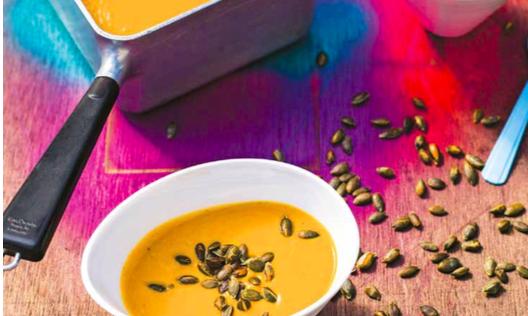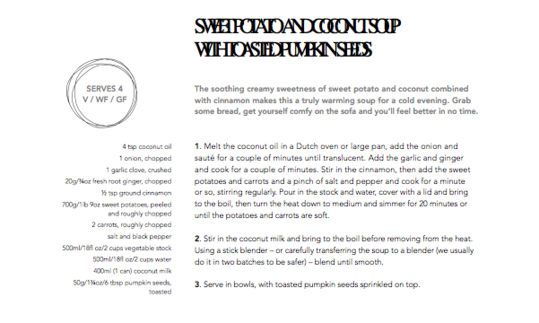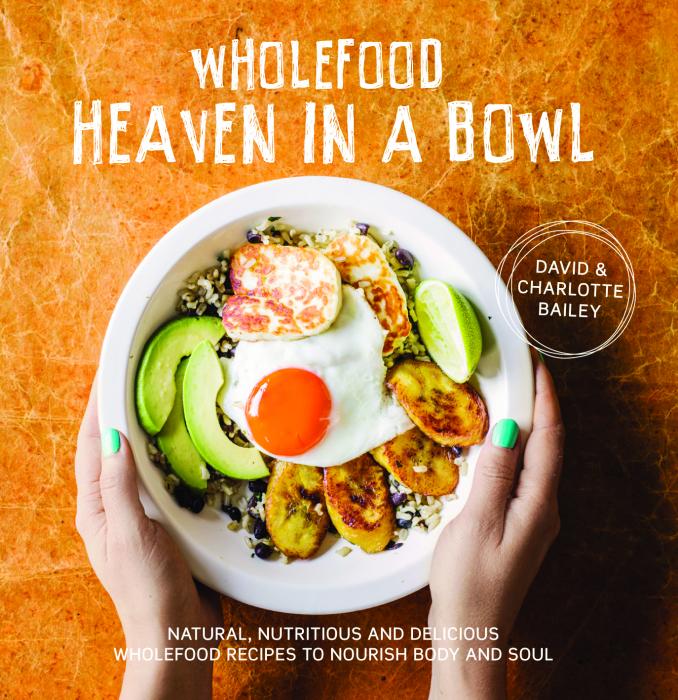Sweet Potato and Coconut Soup with Toasted Pumpkin Seeds
vegan
Ingredients (for servings, )
| For the soup | |
|---|---|
| 1 | Onions, raw (organic?) (3.9 oz) |
| 1 clove | Garlic (organic?) (0.11 oz) |
| ⅔ oz | Ginger, raw (organic?) |
| 1 ⅓ tbsp | Coconut oil (coconut oil, coconut fat, organic?, raw?) (0.63 oz) |
| ½ tsp | Cinnamon (ground, raw, organic?) (0.05 oz) |
| 25 oz | Sweet potatoes, raw |
| 2 | Carrots (carrots), raw (organic?) (4.3 oz) |
| 1 dash | Table salt (table salt, raw?, organic?) (0.01 oz) |
| 1 dash | Black pepper (organic?, raw?) (0.00 oz) |
| 18 oz | Vegetable broth with little salt (organic?) |
| 500 ml | Drinking water, raw (organic?) (18 oz) |
| 400 ml | Coconut milk, preserved (coconut milk, organic?) (13 oz) |
| For the topping | |
| 1 ¾ oz | Pumpkin seeds, dried, raw (organic?) |
Equipment
- blender or hand-held blender / immersion blender
- stove
- saucepan
Type of preparation
- cook
- chop or grind
- sauté
- blend
- melt
- bring to a boil
- remove the skin
- peel
Preparation
Preparing the soup
Peel and chop the onion, garlic, and fresh ginger. Melt the coconut oil in a Dutch oven or large pan. Add the onion and sauté for a couple of minutes until translucent. Add the garlic and ginger and cook for a couple of minutes and stir in the cinnamon.Peel and roughly chop the sweet potatoes. Clean and roughly chop the carrots. Then add the sweet potatoes and carrots to the onion and garlic mixture. Add a pinch of salt and pepper and cook for a minute or so, stirring regularly.
Pour in the stock and water, cover with a lid, and bring to a boil. Then turn the heat down to medium and simmer for 20 minutes or until the carrots and potatoes are soft.
Stir in the coconut milk and bring to a boil before removing from the heat. Using an immersion blender – or carefully transferring the soup to a blender – blend until smooth.
The authors note that to be safer it is best to transfer the soup to a blender in two batches.
Serving
Toast the pumpkin seeds in a skillet. Serve in bowls, with toasted pumpkin seeds sprinkled on top.
|
Nutritional Information per person
Convert per 100g
|
2000 kcal | |
|---|---|---|
| Energy | 484 kcal | 24.2% |
| Fat/Lipids | 31 g | 44.6% |
| Saturated Fats | 23 g | 114.6% |
| Carbohydrates (inc.dietary fiber) | 48 g | 17.7% |
| Sugars | 11 g | 12.5% |
| Fiber | 7.6 g | 30.5% |
| Protein/Albumin | 9.2 g | 18.4% |
| Cooking Salt (Na:468.8 mg) | 1'191 mg | 49.6% |
| Essential micronutrients with the highest proportions | per person | 2000 kcal | |
|---|---|---|---|
| Vit | Vitamin A, as RAE | 1'509 µg | 189.0% |
| Min | Manganese, Mn | 1.9 mg | 96.0% |
| Min | Copper, Cu | 0.70 mg | 70.0% |
| Prot | Tryptophan (Trp, W) | 0.16 g | 64.0% |
| Sodium, Na | 469 mg | 59.0% | |
| Elem | Potassium, K | 1'064 mg | 53.0% |
| Elem | Phosphorus, P | 350 mg | 50.0% |
| Elem | Magnesium, Mg | 172 mg | 46.0% |
| Prot | Threonine (Thr, T) | 0.41 g | 44.0% |
| Min | Iron, Fe | 5.5 mg | 40.0% |
Detailed Nutritional Information per Person for this Recipe
The majority of the nutritional information comes from the USDA (US Department of Agriculture). This means that the information for natural products is often incomplete or only given within broader categories, whereas in most cases products made from these have more complete information displayed.
If we take flaxseed, for example, the important essential amino acid ALA (omega-3) is only included in an overarching category whereas for flaxseed oil ALA is listed specifically. In time, we will be able to change this, but it will require a lot of work. An “i” appears behind ingredients that have been adjusted and an explanation appears when you hover over this symbol.
For Erb Muesli, the original calculations resulted in 48 % of the daily requirement of ALA — but with the correction, we see that the muesli actually covers >100 % of the necessary recommendation for the omega-3 fatty acid ALA. Our goal is to eventually be able to compare the nutritional value of our recipes with those that are used in conventional western lifestyles.
| Essential fatty acids | per person | 2000 kcal |
|---|---|---|
| Linoleic acid; LA; 18:2 omega-6 | 3.0 g | 30.0% |
| Alpha-Linolenic acid; ALA; 18:3 omega-3 | 0.02 g | 1.0% |
| Essential amino acids | per person | 2000 kcal |
|---|---|---|
| Tryptophan (Trp, W) | 0.16 g | 64.0% |
| Threonine (Thr, T) | 0.41 g | 44.0% |
| Phenylalanine (Phe, F) | 0.50 g | 32.0% |
| Valine (Val, V) | 0.50 g | 31.0% |
| Isoleucine (Ile, I) | 0.36 g | 29.0% |
| Leucine (Leu, L) | 0.65 g | 27.0% |
| Lysine (Lys, K) | 0.40 g | 22.0% |
| Methionine (Met, M) | 0.17 g | 18.0% |
| Vitamins | per person | 2000 kcal |
|---|---|---|
| Vitamin A, as RAE | 1'509 µg | 189.0% |
| Vitamin B6 (pyridoxine) | 0.50 mg | 36.0% |
| Pantothenic acid (vitamin B5) | 1.8 mg | 30.0% |
| Folate, as the active form of folic acid (née vitamin B9 and | 51 µg | 26.0% |
| Thiamine (vitamin B1) | 0.23 mg | 21.0% |
| Niacin (née vitamin B3) | 2.6 mg | 16.0% |
| Vitamin C (ascorbic acid) | 9.7 mg | 12.0% |
| Riboflavin (vitamin B2) | 0.15 mg | 11.0% |
| Vitamin K | 8.4 µg | 11.0% |
| Vitamin E, as a-TEs | 0.96 mg | 8.0% |
| Biotin (ex vitamin B7, H) | 3.9 µg | 8.0% |
| Essential macroelements (macronutrients) | per person | 2000 kcal |
|---|---|---|
| Sodium, Na | 469 mg | 59.0% |
| Potassium, K | 1'064 mg | 53.0% |
| Phosphorus, P | 350 mg | 50.0% |
| Magnesium, Mg | 172 mg | 46.0% |
| Calcium, Ca | 101 mg | 13.0% |
| Essential trace elements (micronutrients) | per person | 2000 kcal |
|---|---|---|
| Manganese, Mn | 1.9 mg | 96.0% |
| Copper, Cu | 0.70 mg | 70.0% |
| Iron, Fe | 5.5 mg | 40.0% |
| Zinc, Zn | 2.2 mg | 22.0% |
| Selenium, Se | 2.5 µg | 5.0% |
| Fluorine, F | 91 µg | 3.0% |
| Iod, I (Jod, J) | 2.1 µg | 1.0% |
Pavilion Books Company Ltd, David and Charlotte Bailey
Raw recipes 11, Cooked recipes 58 (4)
Additional photos (7)
“Wholefood Heaven in a Bowl – Natural, Nutritious and Delicious ...,” a Middle Eastern vegetarian cookbook with a strong focus on wholefoods.
SummaryWholefood Heaven in a Bowl – Natural, Nutritious and Delicious Wholefood Recipes to Nourish Body and Soul by David and Charlotte Bailey is a vegetarian cookbook that includes many vegan recipes. It is a good cookbook both for those who have experience with a vegan and/or vegetarian diet and those who are just starting out and are ready to try healthier options. The recipes are international and have a special focus on Asian cuisine; they range from easy to prepare to more challenging dishes.
| Critical book reviews It is not common practice for us to use a vegetarian cookbook as a source, but about 70 % of the recipes in this cookbook are vegan. These are the only type we have on our website. |
Overall impressionIn their cookbook Wholefood Heaven in a Bowl – Natural, Nutritious and Delicious Wholefood Recipes to Nourish Body and Soul, David and Charlotte Bailey have selected recipes with naturally healthy ingredients. The recipes include vegetables, fruits, nuts, seeds, and grains that have been processed and refined as little as possible. David and Charlotte Bailey use a lot of whole grains and ancient grains and avoid highly processed foods and food additives. They also try to keep the amount of added salt, sugar, and oil to a minimum. It is therefore somewhat surprising that canned foods such as legumes or tomatoes are sometimes called for in the recipes. However, this does not occur very often.
It is helpful that above each recipe the authors have listed whether it is a vegan recipe, includes vegan options, if it includes grains, and if it is gluten-free. Tofu products are found in some recipes but are the exception. You will notice right away that the recipes contain a large number of spices. The dishes are international, and many are clearly influenced by Asian cuisine. The ingredients themselves are readily available. Alongside simple and quick dishes, you will also find quite complicated recipes that require planning and time to prepare. However, it would be nice if the recipes, especially the more involved ones, included the preparation time needed. Since most people will not be familiar with recipes like these, it would be nice if there were photos for all of the recipes and not just for most of them.
Wholefood Heaven in a Bowl is a book that has a strong emphasis on health and features many extraordinary, one-of-a-kind recipes. It is a cookbook that offers even experienced vegan cooks numerous new ideas for recipes.
David and Charlotte Bailey have written two books: Wholefood Heaven in a Bowl and The Fresh Vegan Kitchen, both of which are available from Pavilion books and Amazon.
About the authorsDavid Bailey, who has several years of experience working in top restaurants, and his wife Charlotte started their business Wholefood Heaven in 2010. They sell vegetarian street food at markets, festivals, and other events. Their famous Buddha Bowl won the 2011 British Street Food Awards for Best Main Dish. In addition to their business, they are continually developing new recipes and writing cookbooks.
ContentsWholefood Heaven in a Bowl – Natural, Nutritious and Delicious Wholefood Recipes to Nourish Body and Soul begins with an introduction that explains the terms “wholefoods” and “bowls.” The chapter “Wholefood Store Cupboard” provides information about a wide range of ingredients that come under the categories of whole grains, flours, legumes (pulses), nuts and seeds, herbs and spices, tofu and soya chunks, and other things.
The recipes are divided into seven sections:
- Breakfasts and brunch
- Salads
- Soups and stews
- Mains
- Accompaniments and sides
- Baking and desserts
- Drinks
Breakfast and brunch: This chapter is full of sweet and savory international breakfast and brunch options — from muesli to pancakes and the like. Only one recipe is vegan, but two have vegan options. Most of the other vegetarian dishes contain egg and about half of them dairy products. Examples of recipes in this section are Chia Seed Bircher Bowl and Millet Porridge with Prune Compote and Flaked Almonds.
Salads:Most of the salads call for cooked ingredients such as grilled vegetables or grains and therefore are not raw food dishes. Four of the eight recipes are vegan, and two more include vegan options. Seaweed, Wild Rice, Tofu, Sesame and Spring Onion Salad and Wholegrain Glass Noodle Salad with Smoked Tofu and Mixed Sprouts are just two examples of the recipes in this section.
Soups and stews: All of the recipes in this section are vegan or include vegan options. You might try, for example, Sweet Potato and Coconut Soup with Toasted Pumpkin Seeds or the Vietnamese-inspired Pho with Pak Choi, Edamame and Brown Rice Noodles. Apart from canned coconut milk, canned ingredients (here: beans) are only called for on one occasion.
Mains:About two-thirds of the recipes in this largest section of the cookbook are either vegan or include vegan options. About one-third calls for soy products (e.g., tofu or soya chunks) or canned ingredients. Many of the recipes require several ingredients, which means that they take more time and effort to prepare. Some examples of recipes in this section are the famous Buddha Bowl, Ethiopian Kik Alicha (split stew) with Atakilt Wat (spiced cabbage), Cucumber Salad and Injera Flatbread, and Mexican Bean Pot Bowl with Citrus Chard.
Accompaniments and sides:Apart from one exception, all of the dishes in this section are vegan. You will find fermented vegetables such as Basic Kimchi, spice pastes and savory sauces like Seeni Sambol, and vegetable sides and toppings such as Hazelnut Dukkah.
Baking and desserts:The majority of the recipes here contain either eggs or dairy products and therefore are not vegan. An example of one of the three vegan recipes is Vegan Carrot Halwa.
Drinks:Alongside Milky Masala Chai and Tiger’s Milk, this section includes numerous smoothies and refreshing drinks such as the Switchel with lemon and ginger.
Book review written by Dr. med. vet. Inke Weissenborn
Thanks to the ginger, this soothing sweet potato and coconut soup with toasted pumpkin seeds is very warming – and added cinnamon gives it a delicious flavor.
Nutritional profile: Based on the GDA guidelines, one serving of this recipe meets the recommended daily requirement for vitamin A and manganese. In addition, it contains many minerals (sodium, potassium, and phosphorus) and trace elements (copper and iron). However, the ratio of omega-6 to omega-3 fatty acids is not well balanced; instead of the maximum recommended ratio of 5:1, this recipe has a ratio of 150:1.
Please click on the link if your health is important to you:
A Vegan Diet Can Be Unhealthy. Nutrition Mistakes.
Sweet potatoes: Sweet potatoes are not actually potatoes. While they grow as underground tubers, in contrast to regular potatoes they are not part of the nightshade family. Sweet potato leaves are edible and are a food staple in many tropical countries. Sweet potatoes have a high water content and as such can’t be stored for long periods of time like regular potatoes. However, careful handling (e.g., avoiding bruises) can extend the storage life. Since certain varieties contain an appreciable amount of hydrogen cyanide, you should carefully select the type of sweet potato you will be using. A large variety of both sweet and savory dishes can be prepared using sweet potatoes. These tubers are available in a range of colors, including yellow with red skin, orange-red with reddish-brown skin, and white with light-colored skin.
Coconut milk is not coconut water: Coconut milk is made by puréeing coconut flesh with water and then straining through a cheesecloth or nut bag. The result is a milky liquid that has a fat content of about 15 to 25 %. If you run boiling water over the fibrous pulp left behind and then squeeze the cheesecloth out again, you will obtain more coconut milk, but it will be somewhat thinner. Coconut water, not to be confused with coconut milk, is the clear liquid found inside young coconuts.
Ginger: Ginger is aromatic and has a pungent, spicy taste because it contains gingerol, a substance which has anticarcinogenic and anti-inflammatory effects. Thanks to borneol and cineol, ginger promotes digestion, calms the stomach, is effective against vomiting and nausea, and stimulates the appetite and circulatory system. As a cooking ingredient, ginger root is used in several forms including fresh, dried, and ground.
Pumpkin seeds: Dried pumpkin seeds are rich in nutrients (e.g., protein, dietary fiber, iron, zinc, and magnesium). They are a popular snack in the United States, but also work well to add a finishing touch to many dishes.
Making your own coconut milk: For 200 ml of coconut milk, pour 200 ml very hot water on top of about 50–60 g shredded coconut and let stand 10–15 minutes. Then process in a blender or using an immersion blender. Strain liquid through a nut milk bag, pressing out all the liquid you can.
Low-sodium vegetable broth: We use reduced-sodium vegetable broth to decrease the amount of salt with no resulting decrease in flavor. Use your preferences as a guideline when adding salt to this dish.
Homemade vegan vegetable broth: By using salt-free vegetable broth, you will significantly reduce the amount of sodium in this dish. Access our recipe by clicking on this link: Vegan Stock. You can adjust the amount of broth you use depending on how concentrated it is. If you feel it is needed, you can also add salt before serving.






